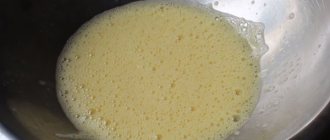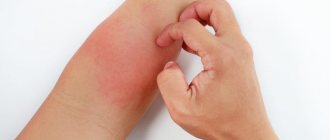What kind of fish to start a child's first complementary feeding (up to one year): when and how to introduce it
Publication date: 04/05/2018 |
A balanced and varied diet is the key to a child’s health. The baby's diet should consist of foods containing a maximum of nutrients. One of these is sea or river fish, which is a source of easily digestible protein necessary for a growing organism. A young mother needs to know when and what kind of fish to introduce into complementary foods, how to act in case of allergies, and what delicious dishes can be enjoyed for her baby.
The benefits of fish for children
The menu of a baby just starting to learn new tastes should be as healthy and varied as possible. In addition to eggs, meat and vegetables, fish is considered one of the most important foods for a child’s diet.
- Fish is a record holder for the content of easily digestible proteins, the amino acid composition of which fully meets the needs of the child’s body.
- In addition to the substance, which is a building material for muscles, the product contains a number of vitamins - A, B2, B12, D, PP and trace elements - zinc, magnesium, copper, phosphorus, calcium, iron.
- Fish in the diet plays the role of a product that is indispensable for improving metabolism and hormone synthesis (in particular, iron that comes with other foods is better absorbed), as it contains Omega-3 polyunsaturated fatty acids.
- The tender flesh of sea creatures, in addition to the above advantages, is saturated with iodine, without which the normal development and functioning of the thyroid gland is impossible.
- There are no refractory fats and connective tissue, which allows the infant's immature enzyme system to easily cope with fish.
This unique composition allows the child to grow and develop normally. In addition, the taste of fish dishes is often liked by infants, who react much more capriciously to the introduction of meat or vegetables into the diet. That is why the question of how to introduce fish into complementary foods worries every caring mother.
When and how to introduce complementary foods into a baby's diet
Fish is usually introduced into complementary foods when the baby is 8-10 months old.
Moreover, this is done only after the child has already started eating other food of animal origin - meat (after 3-4 weeks). A new product can only be given to a healthy child. In case of the slightest health problems, the introduction of complementary foods should be postponed until complete recovery.
Fish is considered one of the most powerful food allergens.
If a child has an allergic predisposition, fish complementary foods must be agreed upon with an allergist and pediatrician. Typically, such children first try a product rich in nutrients after a year.
Acquaintance with new food begins with a minimal portion - no more than half a teaspoon. It is better to introduce complementary foods for the first time during morning feeding: this will allow you to observe the baby throughout the day and draw the right conclusions about how the body reacted to the new product. Do you have a rash or upset bowel movements? Does your baby spit up and become whiny? Refrain from trying to give fish to your child again for a few weeks. The baby’s reaction can be caused by a certain type of fish, so before the next complementary feeding it is better to change tactics, for example, by preparing a puree not from sea fish, but from river fish of the depths.
Some children react acutely only to home-cooked foods, while others have an intolerance to canned food. Determining your baby's preferences can only be done through trial and error.
6 rules for feeding fish
When starting to feed fish, you should adhere to certain rules:
- The best age to introduce a healthy product for babies is 10 months. Artificial babies begin to introduce fish into the menu at 8-9 months.
- The first portion of puree or fish soufflé should be minimal - half a teaspoon. You should not supplement the dish with other unfamiliar products at the initial stage: this will allow you to see the body’s reaction to the product.
- Didn't the first complementary food cause a negative reaction? You can introduce the product in a different dosage: instead of half a teaspoon, give a whole one, gradually increasing the amount of puree, soufflé or meatballs to 50 grams.
- By the age of 12 months, a baby can eat up to 70 grams of product at a time, 2 times a week. After a year, the recommended serving size is 80-90 grams. For allergy sufferers, it is enough to enjoy healthy and easily digestible foods once a week.
- When the baby gets used to the new taste (after 2-3 weeks), the diet can be supplemented with vegetables, cereals, and vegetable oils.
- Fish dishes in the diet should appear twice a week. A portion replaces daily meat feeding.
An allergy is not a reason to abandon the product forever. It is important to monitor the baby’s well-being and, if necessary, transfer complementary feeding to an older age (1-2 years). Symptoms of diathesis or urticaria should be reported to your pediatrician.
What kind of fish to give for the first feeding: the best fish for babies

Pediatricians recommend introducing fish into the diet of a baby fed on breast milk from 10 months. Artificial babies can begin to master new gastronomic tastes from 8-9 months.
The choice of complementary feeding product is very important. Fatty varieties are not suitable for babies or artificial babies. In addition, the bony quality of the product becomes important. By purchasing sea fish, you can facilitate the cooking process and eliminate small bones that can harm your child.
Choosing a product for first feeding
Don't know what fish to start feeding with? Preference should be given to low-fat white varieties.
- Hake.
- Cod.
- Saida.
- Navaga.
- Perch.
- Pollock.
- Flounder.
- Blue whiting.
These varieties are low-fat and low-fat. Fatty varieties (halibut, herring, mackerel), despite their usefulness, are not used as a product for complementary feeding of infants.
Live in an area rich in river fish? The best solution would be varieties such as trout, carp, grass carp and pike perch. River inhabitants cannot boast of a high content of valuable microelements, such as iodine or phosphorus, but they are sources of valuable, easily digestible protein.
Canned or home-cooked food
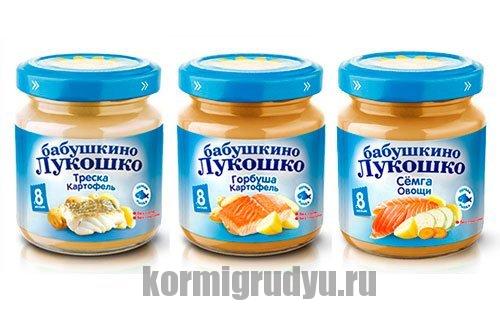
Today, young parents have the opportunity to choose whether to feed their child with special canned food intended for children of different ages, or stick to complementary foods prepared independently. The first option has a number of undeniable advantages.
- Canned fish saves time for a young mother who is constantly busy with household chores.
- Guarantees the quality of the product, provided that the product is purchased from a trusted and well-known manufacturer.
- In addition to fish, the composition includes vitamin-rich vegetables, cereals, and valuable vegetable oils, making the dish as healthy as possible.
- Today on store shelves you can find fish dishes of varying degrees of crushing, which allows you to choose a product that is optimally suitable for your baby (for 8-9 months, pureed canned food is offered, for 10-12 months - coarsely crushed, for children aged 12 to 18 months - in pieces).
Do you prefer to prepare your own complementary feeding meals? This has its advantages. Parents can supplement the dish with their baby’s favorite vegetables and ensure the optimal consistency. A wide selection of easy-to-prepare recipes will make your child’s diet as varied and healthy as possible.
What to look for when purchasing
Do you want to buy fresh, canned or frozen fish for your baby? The mandatory conditions for purchasing a high-quality and safe product are as follows:
- Fish for the first feeding cannot be purchased at the spontaneous market. The purchase should be made in a store that can confirm the freshness of the product with the necessary documents.
- When choosing a chilled product, you need to pay attention to its appearance. Damaged scales, faded gills, cloudy eyes and unnatural coloring are a reason to go shopping to another store.
- Frozen pulp is white when cut. If storage conditions were violated and the product was re-frozen, the color will be dark. If after defrosting you smell rancid fat and find that pressing on the carcass leaves dents, you should not eat such fish.
- When purchasing canned food, you must carefully study the label, paying attention to the manufacturer’s recommendations regarding the child’s age, the composition of the dish and shelf life.
We prepare and store complementary foods (fish) correctly
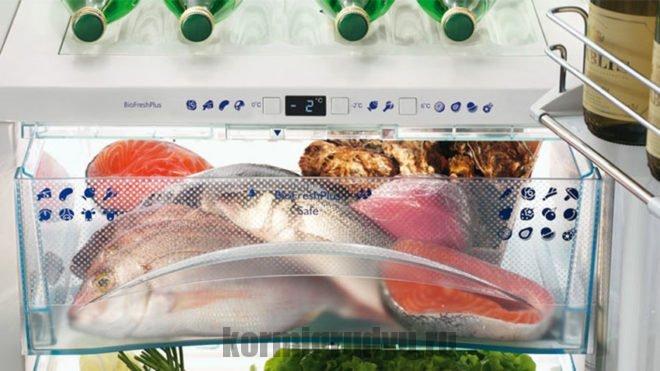
It is important not only to know how and when to introduce fish into the diet, but also to follow the technology for properly preparing the product. The best solution for infants is fish prepared in the form of puree, soufflé or pudding. Broths are not recommended for children under three years of age, so it is better to avoid soup until the baby grows up.
be stored in the refrigerator for no more than 48 hours.
Did you buy a frozen product? Leave it in salted water, which prevents the formation of bacteria. After defrosting, it should be washed, deboned and immediately subjected to heat treatment. Re-placement into the freezer is not permitted.
It should be remembered that fish is a perishable product. Irreversible changes associated with violations during storage or transportation of the product can be dangerous to the baby’s health.
It is better to prepare meals for your baby immediately before consumption. If necessary, the finished puree can be left in the refrigerator. The fish can be boiled or steamed. In the second case, it will retain a maximum of valuable vitamins and microelements.
Recipes for the little ones
- Puree for babies (8-10 months).
Low-fat fish (100 g) is boiled for 15-20 minutes and crushed in a blender. After this, add a teaspoon of milk and the same amount of vegetable oil to the mixture. The puree is returned to the stove and boiled for 1-2 minutes.
- Pudding (10-12 months).
Boiled fillet (100 g) is crushed and combined in a 1:1 ratio with mashed potatoes prepared with the addition of milk and vegetable oil. Beat half an egg with a pinch of salt and add to the mixture. Transfer to special molds and steam for half an hour.
- Puffed meatballs (12-18 months).
You need to prepare minced meat from 60 g of hake or cod fillet, 10 g of pre-soaked bread, a teaspoon of vegetable oil and a quarter of an egg yolk. The formed meatballs are filled halfway with water and simmered over low heat for 30 minutes.
Do you want to make your baby's diet varied and healthy? It is worth introducing fish rich in valuable microelements and vitamins into the menu of an infant who has reached 8-10 months of age. Easily digestible food will take its rightful place on the baby’s table, provided that the basic rules for choosing a product and the technology for its preparation are followed.
All about canned fish
You won’t have to rack your brains about what kind of fish to start feeding your baby with if you trust the professionals.
Increasingly, young mothers periodically visit stores with baby food and create a menu for the baby based on the assortment on the shelves, completely freed from the burden of worrying about feeding their child. Considering this topic, we can highlight the advantages of canned fish dishes in jars:
Disadvantages of ready-made food from the store:
- High price.
- During feeding, most of the product is not used and disappears, because it cannot be left until the next time.
- Judging by the reviews, children are not too fond of canned food. They like home-cooked food better.
- A small number of varieties of meat and fish dishes.
Obviously, the ideal for a child is a competent combination of specialized food products and homemade delicacies prepared with the care of a loving mother.
Which fish is best to start complementary feeding with: introducing fish dishes into the diet of a child 8-10 months to 1 year
Fish is one of the most valuable food products. It, like meat, is an irreplaceable source of high-quality protein that a person needs for the full course of all physiological processes. Dishes made from low-fat fish varieties are much easier and faster absorbed by the child’s body than meat ones. The fish has a delicate consistency, even the digestive system of a small child can “process” it. Lean fish contains significantly fewer calories than meat.
Low-fat fish is very necessary on a baby’s menu - it prepares the body to accept “adult” foods, but is also easily digested
Fish is a real storehouse of vitamins and microelements necessary for active mental and physical activity and to maintain excellent health. In terms of selenium and iodine content, fish firmly holds the palm among other food products. Vitamin D, phosphorus, calcium and fluoride are important building materials for a child's teeth and bones.
In addition, fish is rich in polyunsaturated fatty acids omega-3 and omega-6, which are known to improve the functioning of the cardiovascular and nervous systems, accelerate cell renewal and metabolism, and improve mood. Starting from the second half of life, it should definitely be introduced into complementary foods for a healthy infant.
When and how to introduce fish food?
At what age should fish be introduced into the diet and how much should I give? According to most children's doctors, the introduction of fish complementary foods is possible from 8-10 months, when the child is already accustomed to complementary feeding with meat (see also: when to introduce meat into complementary foods for an infant?). Fish, especially sea fish, can cause an allergic reaction, so your baby should receive fish dishes no more than once every 3 days. You need to introduce fish complementary foods, like any other, little by little, starting with just a few crumbs.
If your baby has a clear tendency to diathesis, fish should not be introduced into his diet earlier than 12 months. Do not give him any other new foods at the same time - this way you will immediately determine how well the child tolerates complementary feeding. If a severe allergic reaction such as urticaria occurs, it would be wiser to delay the introduction of fish supplements for up to two years. It happens that a baby’s allergy is provoked only by a specific type of fish.
If the allergy does not appear, then after 3 days give the child a teaspoon of the same fish dish. Such a temporary break is necessary because allergies to fish protein tend to develop after accumulation in the body. Children should not be offered fish dishes too often. To avoid the risk of developing allergic reactions, fish should be in the baby’s diet no more than 2-3 times a week, and for potential allergy sufferers - once every 7 days.
Little by little, every few days, increase the portion so that by 9-10 months the baby eats 40-50 g at a time, and by one year - 60-70 g. For a child of 10-11 months, fish puree can be alternated with meat puree. After 1 year, pediatricians advise giving your baby 80-90 g of steamed fish balls, puree or boiled fish 2 times a week.
What fish should you give your child first?
What fish should I start feeding my baby with? Let the first fish that a child tries in his life be a low-fat sea fish without small bones. It is readily available for sale:
- pollock;
- hake;
- whiting;
- flounder;
- cod.
Among the river species you can try as complementary foods:
- zander;
- White amur;
- carp.
Sea fish is usually sold fresh frozen. Do not defrost it completely - you just need to let it thaw a little in salted water, then cut it into pieces and cook. This way it will retain more vitamins. River fish must be purchased alive, otherwise there is a risk of purchasing a spoiled product.
Many young children really like fish dishes and eat them willingly. It is too early to seat a child 8-11 months old at a common table; he needs to cook separately. You can bake fish for it, boil it, steam it, make a soufflé, but under no circumstances fry it! Make sure that there are no small bones left in the cooked fish.
Soufflé is another interesting way to serve fish on a children's menu. It is very important to remove all the bones during cooking.
Fish dishes for children up to one year old
Let's learn how to cook simple fish dishes for a baby 8-11 months old, for example:
Hake meatballs
Wash hake fillet (250 g) and pass through a meat grinder. Add to the minced meat 1 small raw egg, 1 tbsp. spoon of washed rice, salt to taste. Mix everything thoroughly and form small meatballs. Scald the tomato with boiling water, remove the skin and cut into slices. 1 sweet pepper, seeded and cut into strips. Lightly fry the vegetables for 4 - 5 minutes, then place the meatballs on them, fill everything with hot water and simmer on low heat under the lid for about 20 minutes. The meatballs should be half covered with water. There are other recipes.
Fish puree
Boil fillet (100 g) of any fish suitable for the child, cool, then grind in a blender. Add 1 tablespoon of warm milk and 1 teaspoon of sunflower oil to the resulting puree. Put it back on the fire, bring to a boil, cool. This puree can be stored in a tightly sealed container in the refrigerator for up to two days.
Pike perch soufflé
Take 300 g of pike perch fillet, wash it, cut it into pieces and grind it in a blender. Separate the yolk of a raw egg from the white, pour the yolk into the minced meat and beat again. Then prepare the milk sauce: fry half a tablespoon of flour in a frying pan until golden brown, little by little add 50 ml of milk and 1 tablespoon of butter. Cook until it thickens. Mix the prepared sauce with the minced meat. Whip the remaining egg white into a thick foam and also pour into the minced meat, stirring gently. Place the soufflé in animal-shaped molds and place in an oven preheated to 160 degrees. After 20 minutes the soufflé will rise and brown. The baby will be delighted.
Fish pudding
Cook 200 g of the pulp of any fish, and at the same time cook the potatoes in another saucepan. Knead the finished products with a fork and combine them together. Add 1 beaten egg, a quarter glass of milk and 1 tablespoon of butter to the resulting puree. Mix everything and put it in the mold. Place in a double boiler and in half an hour the pudding will be ready.
Steam cutlets
Pass 50 g of fish fillet through a meat grinder, add white bread (20 g) soaked in milk. Mix the minced meat and pass it through the meat grinder again. Beat half the egg, add a little salt to taste and knead. Steam the cutlets for 20-30 minutes in a double boiler or on a special grill (designed for ordinary pans).
Fish meatballs
It doesn’t matter what kind of fish to start feeding your child with if we are talking about meatballs. This dish will also appeal to kids who are indifferent to fish. Even adults have a hard time guessing what type of seafood was used.
Ingredients for one serving:
- Any fish fillet – 1 piece.
- Egg - 1/4 piece.
- Sweet loaf pulp, mashed in milk (in case of milk intolerance, in water) – 1 handful.
- Ghee – ½ tablespoon.
- A pinch of salt.
Place all ingredients in a blender and blend. Form meatballs, roll in flour and place in boiling water. Cook for 15 minutes until done. They can also be steamed and cooked in a slow cooker. But it will take twice as long.
Complementary feeding: introducing fish into a child’s diet
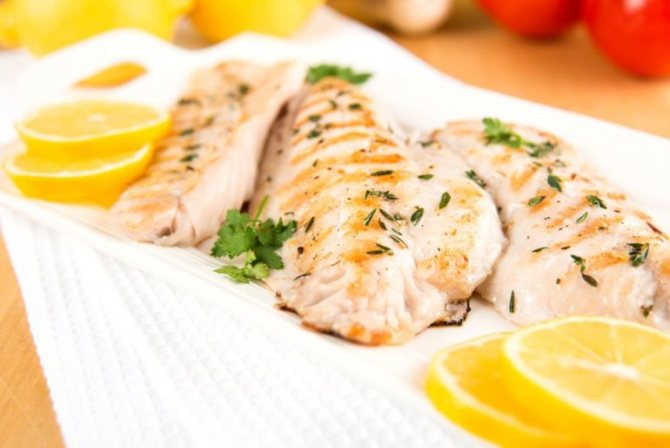
Fish in a baby’s diet: when and how to introduce it
Fish is an ideal protein product for any age: it contains a lot of protein, and, moreover, fish protein is absorbed by the body much better than meat or milk protein. Why do mothers introduce fish into their child’s complementary foods with great caution? The thing is that this product is highly allergenic. That is why doctors recommend accustoming the baby to it consistently, gradually and carefully, carefully observing the reaction.

When to introduce fish into complementary foods? General recommendations
Fish appears on the baby’s menu after he has “mastered” meat. This happens between 7 and 9 months. We are now talking about babies with good tolerance to the product. If allergic reactions to fish were observed even during active breastfeeding (when the mother ate fish), you can postpone this matter even for up to a year.
If, after the first fish meal, you notice the appearance of hives, diathesis, indigestion, swelling of the face or a general decrease in health in your child, you should stop introducing fish into complementary foods, wait 2-3 weeks, and then try again, but with a different variety: Children can often suffer from intolerance to a particular fish and accept another well, or have an allergic reaction to sea fish and can easily tolerate river fish.
Traditionally, the need for fish supplements during breastfeeding occurs a month or two later than during artificial feeding.

Choosing a delicacy: which fish to introduce first into complementary feeding
There are several requirements for the fish chosen for the first acquaintance. Here are the main ones:
- The children's digestive system best tolerates low-fat varieties such as hake, flounder, blue whiting, pollock, freshwater trout, and river perch. One of them should become the first fish to feed your child;
- If we are talking about complementary feeding for children under one year old, it is advisable to prefer sea fish to river fish: it has fewer small bones, a higher content of useful iodine, and, moreover, from an environmental point of view, sea fish is much safer than that found in our not very clean rivers and lakes ;
- It is advisable to choose only fresh, chilled fish for feeding your baby - with pink gills, light eyes and evenly shiny scales. If the only product available to you is frozen, try to find the highest quality product.
Later, when the child gets used to the new dishes in the diet and demonstrates their excellent tolerance to the mother, you can gradually move on to fattier varieties, and after a year - to almost any freshwater fish.
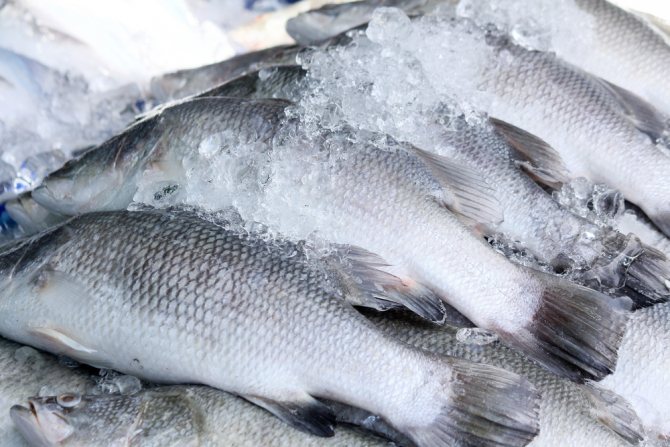
How to prepare fish for first feeding: important recommendations
Definitely don't fry. Suitable cooking methods include boiling, stewing, and steam bath. The culinary process consists of several stages:
- thaw a frozen carcass or thoroughly rinse a chilled carcass;
- clean the fish from scales;
- remove the entrails, carefully remove the bones, fillet;
- select a portion and cut it out. Let it be the central part of the fillet, not at the head and not near the tail;
- cook using your chosen method. River fish can be slightly salted; sea fish, as a rule, does not need this. When cooking, the workpiece should be immersed in boiling water - this way it will be more juicy and will not fall apart.
Opinions vary on how long to cook fish for complementary feeding. Some believe that 10-15 minutes is enough for as many useful substances as possible to remain in the pulp, others are inclined towards longer cooking, up to an hour. We recommend deciding according to the situation: if the fibers separate from each other without the slightest effort, then the fish can be considered ready for your baby.
In order for the new product to be better absorbed, it should be crushed. Moreover, a baby at this age usually does not have many teeth. The best option is a blender. If you don't have one, you can do this with a cleaver knife.
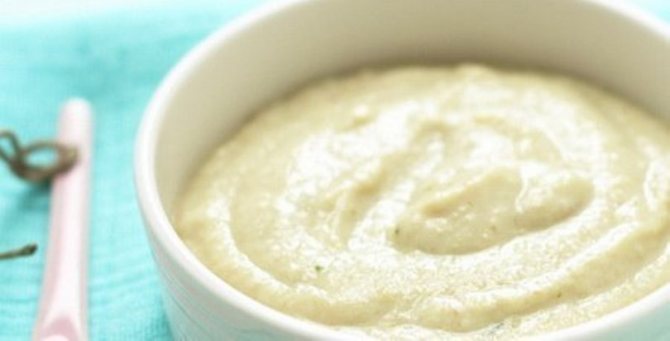
Feeding fish: how much can you offer your child for the first and subsequent times?
As we have already mentioned, this product is highly allergenic. Therefore, fish for the first feeding should be given to a child in a volume of 5-7 grams, mixed with the usual food - porridge cooked in water, vegetable puree. You should not add fish to dairy dishes - these ingredients do not combine well with each other in terms of digestibility, and the taste is not too refined. But fish and eggplant go perfectly together for complementary feeding, as well as with zucchini, carrots, potatoes, millet, rice, buckwheat and even semolina.
Later, at 10-12 months, fish puree is replaced with meatballs, meatballs, and steamed cutlets.
If well tolerated, the volume of the new product can be gradually increased to 10-15 g over 2-3 weeks, then add 10 g every week. Thus, by about a year, your child’s fish portion will reach 50-60 g.
Medical science claims that an allergy to fish can develop not after a single intake, but as its specific protein accumulates in the body. Therefore, it is advisable to arrange “fish days” for your baby no more than 2-3 times a week, respectively, about 15-20 times a month. Daily use of this product is not recommended even for adults, let alone infants with their imperfect gastrointestinal tract.

Cooking “baby fish soup”: how to cook fish for complementary feeding as a first course
Children are often much more willing to enjoy first courses than adults. This is an excellent reason to pamper your child with a tasty and healthy fish soup. We present to your attention a simple step-by-step recipe for this wonderful dish.
Step 1: Select the appropriate fish and prepare it as we recommended earlier.
Step 2: Boil water.
Step 3: Place the fillet in boiling water and remove the foam with a slotted spoon.
Step 4: put some roots, onion, carrots into the broth.
Step 5: simmer the fish and vegetables until fully cooked, then remove from the liquid.
Step 5: Strain the broth well, then return the ingredients to it.
Step 6: Boil again, add finely chopped potatoes and, if desired, a little of your child’s favorite cereal.
Step 7: after the potatoes and cereal are boiled, remove the pan from the heat, cool slightly, pour a portion into a plate, add chopped herbs, add salt if necessary, mash everything with a fork or whisk until a relatively homogeneous mass.
You can try it yourself: it’s delicious. Bon appetit to you and your baby!
Benefits and harms
The usefulness of seafood lies in the abundance of macro and microelements, amino acids, and vitamins in its composition. Fish is rich in valuable fats, fat-soluble vitamins A, D, E, iodine, fluorine, zinc. Its meat is tender, without hard fibers, which facilitates easy absorption of valuable protein by the baby’s still unformed gastrointestinal tract.
The harm lies in the fact that fish can cause a fairly strong allergic reaction, especially marine species, of which cod is the most dangerous. It is important to know that unlike protein, fish oil is not considered allergenic. Even during cooking, allergens are released through steam and can harm a particularly sensitive body by penetrating through the respiratory tract.
Which fish is best to start complementary feeding with: introducing fish dishes into the diet of a child 8-10 months to 1 year
Fish is one of the most valuable food products. It, like meat, is an irreplaceable source of high-quality protein that a person needs for the full course of all physiological processes. Dishes made from low-fat fish varieties are much easier and faster absorbed by the child’s body than meat ones. The fish has a delicate consistency, even the digestive system of a small child can “process” it. Lean fish contains significantly fewer calories than meat.
Low-fat fish is very necessary on a baby’s menu - it prepares the body to accept “adult” foods, but is also easily digested
Fish is a real storehouse of vitamins and microelements necessary for active mental and physical activity and to maintain excellent health. In terms of selenium and iodine content, fish firmly holds the palm among other food products. Vitamin D, phosphorus, calcium and fluoride are important building materials for a child's teeth and bones.
In addition, fish is rich in polyunsaturated fatty acids omega-3 and omega-6, which are known to improve the functioning of the cardiovascular and nervous systems, accelerate cell renewal and metabolism, and improve mood. Starting from the second half of life, it should definitely be introduced into complementary foods for a healthy infant.
When and how to introduce fish food?
At what age should fish be introduced into the diet and how much should I give? According to most children's doctors, the introduction of fish complementary foods is possible from 8-10 months, when the child is already accustomed to complementary feeding with meat (see also: when to introduce meat into complementary foods for an infant?). Fish, especially sea fish, can cause an allergic reaction, so your baby should receive fish dishes no more than once every 3 days. You need to introduce fish complementary foods, like any other, little by little, starting with just a few crumbs.
If your baby has a clear tendency to diathesis, fish should not be introduced into his diet earlier than 12 months. Do not give him any other new foods at the same time - this way you will immediately determine how well the child tolerates complementary feeding. If a severe allergic reaction such as urticaria occurs, it would be wiser to delay the introduction of fish supplements for up to two years. It happens that a baby’s allergy is provoked only by a specific type of fish.
If the allergy does not appear, then after 3 days give the child a teaspoon of the same fish dish. Such a temporary break is necessary because allergies to fish protein tend to develop after accumulation in the body. Children should not be offered fish dishes too often. To avoid the risk of developing allergic reactions, fish should be in the baby’s diet no more than 2-3 times a week, and for potential allergy sufferers - once every 7 days.
Little by little, every few days, increase the portion so that by 9-10 months the baby eats 40-50 g at a time, and by one year - 60-70 g. For a child of 10-11 months, fish puree can be alternated with meat puree. After 1 year, pediatricians advise giving your baby 80-90 g of steamed fish balls, puree or boiled fish 2 times a week.
What fish should you give your child first?
What fish should I start feeding my baby with? Let the first fish that a child tries in his life be a low-fat sea fish without small bones. It is readily available for sale:
- pollock;
- hake;
- whiting;
- flounder;
- cod.
Among the river species you can try as complementary foods:
- zander;
- White amur;
- carp.
Sea fish is usually sold fresh frozen. Do not defrost it completely - you just need to let it thaw a little in salted water, then cut it into pieces and cook. This way it will retain more vitamins. River fish must be purchased alive, otherwise there is a risk of purchasing a spoiled product.
Many young children really like fish dishes and eat them willingly. It is too early to seat a child 8-11 months old at a common table; he needs to cook separately. You can bake fish for it, boil it, steam it, make a soufflé, but under no circumstances fry it! Make sure that there are no small bones left in the cooked fish.
Soufflé is another interesting way to serve fish on a children's menu. It is very important to remove all the bones during cooking.
Fish dishes for children up to one year old
Let's learn how to cook simple fish dishes for a baby 8-11 months old, for example:
Hake meatballs
Wash hake fillet (250 g) and pass through a meat grinder. Add to the minced meat 1 small raw egg, 1 tbsp. spoon of washed rice, salt to taste. Mix everything thoroughly and form small meatballs. Scald the tomato with boiling water, remove the skin and cut into slices. 1 sweet pepper, seeded and cut into strips. Lightly fry the vegetables for 4 - 5 minutes, then place the meatballs on them, fill everything with hot water and simmer on low heat under the lid for about 20 minutes. The meatballs should be half covered with water. There are other recipes.
Fish puree
Boil fillet (100 g) of any fish suitable for the child, cool, then grind in a blender. Add 1 tablespoon of warm milk and 1 teaspoon of sunflower oil to the resulting puree. Put it back on the fire, bring to a boil, cool. This puree can be stored in a tightly sealed container in the refrigerator for up to two days.
Pike perch soufflé
Take 300 g of pike perch fillet, wash it, cut it into pieces and grind it in a blender. Separate the yolk of a raw egg from the white, pour the yolk into the minced meat and beat again. Then prepare the milk sauce: fry half a tablespoon of flour in a frying pan until golden brown, little by little add 50 ml of milk and 1 tablespoon of butter. Cook until it thickens. Mix the prepared sauce with the minced meat. Whip the remaining egg white into a thick foam and also pour into the minced meat, stirring gently. Place the soufflé in animal-shaped molds and place in an oven preheated to 160 degrees. After 20 minutes the soufflé will rise and brown. The baby will be delighted.
Fish pudding
Cook 200 g of the pulp of any fish, and at the same time cook the potatoes in another saucepan. Knead the finished products with a fork and combine them together. Add 1 beaten egg, a quarter glass of milk and 1 tablespoon of butter to the resulting puree. Mix everything and put it in the mold. Place in a double boiler and in half an hour the pudding will be ready.
Marine
The benefits of sea fish include the following:
- Contains a large amount of omega polyunsaturated fatty acids.
- Maximum iodine content.
- Sea inhabitants are less infected with parasites and chemical poisons, which cannot be said about freshwater fauna. This is a significant criterion in deciding which fish to start feeding a child with.
- Easy to debone. In some species they are large, while in others there are very few of them.
- A wide price range allows you to choose a fish that suits your pocket.
Unfortunately, you can rarely find freshly caught fish in stores. It is usually delivered frozen.



